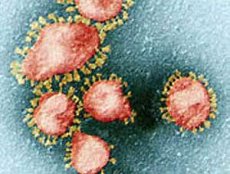
All iLive content is medically reviewed or fact checked to ensure as much factual accuracy as possible.
We have strict sourcing guidelines and only link to reputable media sites, academic research institutions and, whenever possible, medically peer reviewed studies. Note that the numbers in parentheses ([1], [2], etc.) are clickable links to these studies.
If you feel that any of our content is inaccurate, out-of-date, or otherwise questionable, please select it and press Ctrl + Enter.
Respiratory coronaviruses (Coronaviridae)
Medical expert of the article
Last reviewed: 06.07.2025

The Coronaviridae family, which includes two genera, Coronavirus (which also includes the causative agents of gastroenteritis in children) and Torovirus, includes round viruses with a diameter of 50-220 nm. The virions have a supercapsid with 12-24 nm long spikes protruding above it. They consist of a thin neck and a massive spherical or pear-shaped head and resemble the figure of the solar corona, which is why the family was named coronaviruses. The nucleocapsid is located in the core of the virion. Of all RNA viruses, KopoHaj viruses have the largest genome in the form of single-stranded, unfragmented positive RNA of 27,000-32,000 bp. The virion contains 3 groups of proteins: nucleocapsid protein associated with RNA; matrix protein and glycosylated supercapsid proteins that give the virus the ability to adsorb onto cell receptors and penetrate into it. The natural hosts of coronaviruses are humans, domestic and wild animals, in which they cause widespread diseases.
Respiratory coronaviruses are divided into 3 serogroups. Infection from a sick person occurs through airborne droplets; morbidity is sporadic. Epidemic outbreaks of coronavirus infections in the form of fever, runny nose, bronchitis and pneumonia are observed mainly in the cold season. Before the emergence of SARS, these outbreaks were most often caused by the HCV-209E coronavirus.
In November 2002, an outbreak of a disease called SARS (Severe Acute Respiratory Syndrome) or atypical pneumonia occurred in China; it was described in Hong Kong by K. Urbani. The disease began to spread rapidly and, according to WHO, as of June 19, 2003, 8,462 cases of SARS had been registered in 32 countries (most of all in China (7,058)). 804 people died (fatality rate of about 9.5%). One case was registered in Russia. Thanks to vigorous preventive measures taken at the initiative of the WHO (mandatory hospitalization, isolation, quarantine, widespread use of cotton-gauze masks, etc.), the SARS epidemic was eliminated by June 2003, however, several more cases of the disease were later identified, and the risk of a recurrence of the epidemic cannot be ruled out. The SARS pathogen was discovered in April 2003. It turned out to be a coronavirus unrelated to any of the known strains of this virus. Its genomic RNA consists of 29,727-29,736 bp. In terms of nucleotide sequences, the SARS virus differs by 50-60% from the three known serogroups of coronaviruses.
Natural carriers of the virus have not yet been precisely identified. They may be rats, other rodents, insects. In China, it is believed that its main carrier is a small predator, the Asian or eastern civet (Viverra zibetha). It is bred in cages for sale, since its meat is highly valued by gourmets. The main biological feature of the virus is its high contagiousness, which is many times higher than that of viruses that cause various acute respiratory infections, including influenza. The reason for this is also unclear.
SARS diagnostics
Laboratory diagnostics of coronavirus infections, including SARS, is carried out by isolating virus cultures and identifying them, or by determining virus-specific antibodies and increasing their titer in paired sera using various serological reactions or using DNA and RNA probes, PCR. In particular, several types of primers have already been proposed for diagnosing SARS using PCR. Any biological material can be used to detect the RNA virus using PCR: blood, sputum, urine, feces, etc. However, all proposed test systems for diagnosing SARS require additional study of their degree of specificity.
SARS Treatment
Treatment of coronavirus diseases, including SARS, is based on the use of antiviral drugs: ribavirin, interferons, specific immunoglobulins (blood plasma of people who have recovered from SARS); to prevent bacterial complications - antibiotics (beta-lactams, fluoroquinolones, cephalosporins, tetracyclines).


 [
[